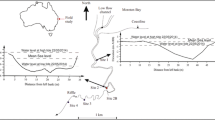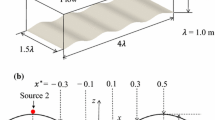Abstract
Mean concentration fields of strongly advected non-buoyant discharges are characterised with a double-Gaussian assumption. Comparisons with experimental data show that the approximation provides a reasonable representation of the cross-sectional profiles. The self-similarity of these profiles enables their form to be represented by two additional parameters, one describing the relative separation of the peaks and the other the ratio of the cross-sectional spreads. Values for these additional parameters are determined from experimental data. This systematic approach to characterising the strongly advected flows provides a consistent framework for determining spreading rates and concentration ratios, such as the peak to centreline maximum and the peak to top hat. The double-Gaussian framework also provides a basis for comparisons with the CorJet and VisJet numerical models. In addition the double-Gaussian assumption is employed to interpret data obtained using the Light Attenuation technique. This is a relatively simple measuring system, which provides depth integrated concentration information. The data obtained using this technique is shown to be generally consistent with that from previous studies.
Similar content being viewed by others
References
Jirka GH (2004) Integral model for turbulent buoyant jets in unbounded stratified flows part 1: single round jet. J Env Fluid Mech (4):1–56
Lee JWH, Cheung V, Wang WP, and Cheung SKB (2000) Lagrangian modeling and visualization of rosette outfall plumes. Proceedings of the Hydrodynamics 2000, Iowa, 23–27 July 2000
Knudsen M (1988) Buoyant horizontal jets in an ambient flow. PhD Thesis, Department of Civil Engineering, University of Canterbury, Christchurch, New Zealand
Davidson MJ, Knudsen M, Wood IR (1991) Behaviour of a single, horizontally discharged, buoyant flow in a non-turbulent coflowing ambient fluid. J Hydr Res IAHR 29(4):545–566
Cheung V (1991) Mixing of a round buoyant jet in a current Ph.D. Thesis, Department of Civil Engineering, The University of Hong Kong
Wong CF, Lee JHW (1991) Experiments on advected line thermals. In: Proceedings of the international symposium on environmental hydraulics, Hong Kong, 16–18 December 1991. A.A. Balkema, Rotterdam, The Netherlands
Gaskin S (1995) Single buoyant jet in a crossflow and the advected line thermal. PhD Thesis, Department of Civil Engineering, University of Canterbury, Christchurch, New Zealand
Chu PCK (1996) Mixing of turbulent advected line puffs. Ph.D. Thesis, Department of Civil and Structural Engineering, The University of Hong Kong, Hong Kong
Davidson MJ (1989) The behaviour of single and multiple, horizontally discharged, buoyant flows in a non-turbulent coflowing ambient. Ph.D. Thesis, Department of Civil Engineering, University of Canterbury, Christchurch, New Zealand
Wong CF (1991) Advected line thermals and puffs. M.Phil. Thesis, The University of Hong Kong, Hong Kong
Kikkert GA (2006) Buoyant jets with two and three-dimensional trajectories. Ph.D. Thesis, Department of Civil Engineering, University of Canterbury, Christchurch, New Zealand
Davidson MJ, Pun KL (1998) Hybrid model for prediction of initial dilutions from outfall discharges. J Hyd Eng ASCE 124(12):1188–1197
Kikkert GA, Davidson MJ, Nokes RI (2004) Light attenuation data from weakly and strongly advected discharges. In: Proceedings of the 4th international symposium on environmental hydraulics, vol. 1, pp337–342
Nokes RI (2005) ImageStream Version 4.01. Manual, Department of Civil Engineering, Christchurch, New Zealand
Cenedese C, Dalziel S (1998) Concentration and depth fields determined by the light transmitted through a dyed solution. In: Proceedings of the 8th international symposium on flow visualization (ISFV’98), Sorento, Italy
Wright SJ (1977) Mean behaviour of buoyant jets in a crossflow. J Hydraulic Div ASCE 103(HY5):499–513
Fan LN (1967) Turbulent buoyant jets into stratified or flowing ambient fluids. Report No. KH-R-15, W. M. Keck Laboratory of Hydraulic and Water Resources, Carlifornia Institute of Technology, Pasadena, CA
Pratte BD, Baines WD (1967) Profiles of round turbulent jet in cross flow. J Hydraulic Div ASCE 93(HY6):53–64
Hung WK (1998) A jet at an oblique angle to a cross-flow. Project Thesis, Department of Civil Engineering Department, The Hong Kong University of Science and Technology, Hong Kong
Jordinson R (1956) Flow in a jet directed normal to a wind. Technical Report R & M 3974,British ARC
Keffer JF, Baines WD (1963) The round turbulent jet in a cross-wind. J Fluid Mech 15(4):481–497
Chu VH, Goldberg MB (1974) Buoyant forced plumes in crossflow. J Hydraulic Div ASCE (122(1)):27–34
Author information
Authors and Affiliations
Corresponding author
Rights and permissions
About this article
Cite this article
Kikkert, G.A., Davidson, M.J. & Nokes, R.I. Characterising strongly advected discharges in the initial dilution zone. Environ Fluid Mech 7, 23–41 (2007). https://doi.org/10.1007/s10652-006-9011-6
Received:
Accepted:
Published:
Issue Date:
DOI: https://doi.org/10.1007/s10652-006-9011-6




